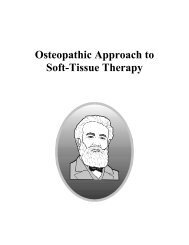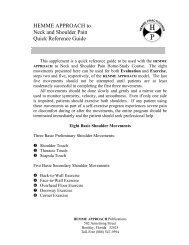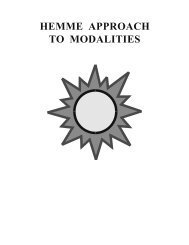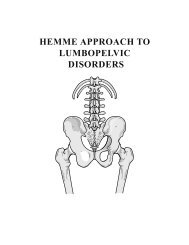HEMME APPROACH TO SOFT-TISSUE THERAPY
HEMME APPROACH TO SOFT-TISSUE THERAPY
HEMME APPROACH TO SOFT-TISSUE THERAPY
You also want an ePaper? Increase the reach of your titles
YUMPU automatically turns print PDFs into web optimized ePapers that Google loves.
comes first, inflammation of the joint and periarticular tissue is likely to<br />
continue until hypertonic muscles surrounding the joint relax and lengthen.<br />
Continued shortness in a muscle that crosses a joint (1) reduces joint space,<br />
(2) causes abnormal friction, (3) inflames the joint capsule, and (4) erodes<br />
articular cartilage. Treatments such as high-velocity manipulation that have no<br />
permanent effect on surrounding muscles and related tissues will do nothing<br />
more than provide temporary relief. If joints and related muscles are not<br />
treated together as a unit, the body cannot heal itself and pain cycles that cause<br />
weakness and limited range of motion are likely to continue.<br />
Setbacks and reversals are common when treating pain cycles.<br />
Even without secondary gain or litigation neuroses, progressive<br />
improvement will sometimes reverse itself for no apparent reason. The<br />
leading cause appears to be higher levels of activity. As patients improve, they<br />
feel better, become more active, and place more demands on the body. Despite<br />
feelings of well-being, patients should be advised to avoid strenuous activities<br />
until the entire body can handle the added stress. The deconditioning effects<br />
of inactivity are difficult to overcome. Besides pain-free range of motion,<br />
patients need strength, muscular endurance, aerobic endurance, and<br />
coordination to function normally.<br />
The methods for treating soft-tissue injuries are often deficient.<br />
In many cases, soft-tissue therapy begins too late or the methods of<br />
treatment are not appropriate for the problem. If an injury is not mobilized as<br />
soon as possible, pain, spasm, and fibrosis may limit the victim's range of<br />
motion and decrease activity. Extended periods of inactivity may cause<br />
deconditioning—weakness, atrophy, incoordination, or stiffness—and other<br />
pathologic changes that lay the groundwork for a long and durable pain cycle.<br />
Modalities or medication used without manipulation are seldom effective, and<br />
splints or braces worn for more than a few days retard healing, decrease range<br />
of motion, and may cause contractures or capsular adhesions.<br />
Another form of inappropriate treatment is too much focus on reports of<br />
pain by the patient and not enough concentration on restoring function.<br />
8<br />
<strong>HEMME</strong> Approach to Soft-Tissue Therapy









